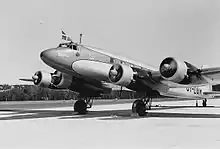Danish Air Lines
Det Danske Luftfartselskab A/S or DDL, trading in English as Danish Air Lines, was Denmark's national airline from 1918 until it merged to create Scandinavian Airlines System (SAS) in 1951. DDL was established on 29 October 1918, but started its first scheduled route on 7 August 1920.
| |||||||
| Founded | October 29, 1918 | ||||||
|---|---|---|---|---|---|---|---|
| Commenced operations | August 7, 1920 | ||||||
| Ceased operations | 1951 (merged with DNL and SILA to form SAS) | ||||||
History
In 1920, the first airplane, a Flugzeugbau Friedrichshafen 49c, was acquired from the Deutsche Luft-Reederei (D.L.R.) in Germany. The airplane, with the previous German navy registration 1364, was almost new, and had been refitted for passenger transport before being delivered from Germany. It received the Danish registration letters T-DABA, and was used for the Copenhagen-Malmö-Warnemünde route in cooperation with the D.L.R. This plane was later returned to Germany, apparently because the transfer was not in accordance with the Versailles treaty.
In 1921 another F.F.49c plane from D.L.R. was acquired as a replacement for the first, with the previous German navy registration 3078. For unknown reasons this airplane used the same Danish registration T-DABA.
In the early 1920s, the airline relied on four chartered Fokker-Grulich F.III aircraft,[2] but also Dornier Komet, Junkers F.13s and the Airco DH.9.[3]
In 1926 the first of a total of four Farman F.121 Jabiru 4-engined commercial airliners, seating nine passengers, were acquired.[4] It was registered as T-DOXB, and was used on the Copenhagen to Amsterdam line. Amsterdam was a hub with connections to London and Paris. The aircraft were withdrawn from use in 1928 and 1929, and broken up by 1931.
In the late 1920s, Fokker F.VII single-engined airliners replaced the somewhat problematic and expensive to operate Farmans.[3][5]
In 1933, the airline got the first of two 16 passenger Fokker F.XII airliners. They were built under license by Orlogsværftet. Both aircraft were scrapped by 1946.[6][7]

In 1938, two Focke-Wulf Fw 200 Condor 26 passenger airliners[8] were acquired. One, Dania, was seized by the British after Denmark was invaded by German forces in 1940, and damaged beyond repair in 1941. The other, Jutlandia, survived the war and continued in DDL service until damaged beyond repair at Northolt in 1946. In 1946, the airline started intercontinental traffic in cooperation with Det Norske Luftfartselskap and Svensk Interkontinental Lufttrafik in an SAS Agreement. On October 1, 1950 representatives from the three airlines signed a consortium agreement where they appointed SAS to run the airline operations. DDL thus changed status from being an active airline into becoming a holding company for the Danish interests within SAS.
Accidents and incidents
- On 2 May 1933, Fokker F.VIIa OY-DAC crashed in fog while approaching Hannover, killing the pilot; the aircraft was operating a cargo (mail) flight.
- On 17 December 1945, Fokker F.XII OY-DIG Merkur was written off after crashing at Kastrup Airport.[9]
- On 30 January 1946, Boeing B-17G OY-DFE Trym Viking ran off the runway and struck RAF Dakota KG427 while landing at Kastrup Airport; there were no casualties, but both aircraft were written off.
- On 4 September 1946, Focke-Wulf Fw 200A-05 Condor OY-DEM Jutlandia was written off following a crosswind landing at Northolt Airport.[10]
- On 17 February 1947, Douglas C-47A OY-AEB Rane Viking force-landed on the ice off Malmö due to fuel exhaustion. While approaching Copenhagen the crew encountered fog and poor visibility and diverted to Malmö, but the weather there was also poor. The crew decided to return to Copenhagen but the aircraft ran out of fuel and force-landed on the ice and burned out.[11]
- On 29 December 1947, Vickers Viking 1B OY-DLI Torulf Viking lost control, stalled and crashed in shallow water while on approach to Kastrup Airport; all 24 on board survived, but the aircraft was written off.[12]
- On 12 February 1948, Douglas C-53 OY-DCI Sejr Viking crashed in a field at Ulrichstein, Germany while on approach to Frankfurt following engine failure, killing 12 of 21 on board.[13]
- On 8 February 1949, Vickers Viking 1B OY-DLU Torlak Viking crashed in the sea off Barsebäck, Sweden, killing all 27 on board; the wreckage was found a month later in 23 m (75 ft) of water. The accident remains the second deadliest in Sweden, behind Linjeflyg Flight 277.[14]
References
- http://www.timetableimages.com/ttimages/dd/dd48/dd48-02.jpg
- "Fokker-Grulich F.III - Untitled". Airliners.net. Retrieved 20 June 2016.
- "T-DOFB". Ed Coates' Collection. Retrieved 20 June 2016.
- "Farman F.121 Jabiru in Danish service". European Airlines. Retrieved 20 June 2016.
- "Fokker F.VIIa - KLM - Royal Dutch Airlines". Airliners.net. Retrieved 20 June 2016.
- "OY-DAJ". Ed Coates' Collection. Retrieved 20 June 2016.
- "Fokker, a living history". Library ThinkQuest. Archived from the original on 4 June 2002. Retrieved 20 June 2016.
- "DDL Timetable April 1939". Airline Timetable Images. Retrieved 20 June 2016.
- Accident description for OY-DIG at the Aviation Safety Network. Retrieved on 2016-6-21.
- Accident description for OY-DEM at the Aviation Safety Network. Retrieved on 2016-6-21.
- Accident description for OY-AEB at the Aviation Safety Network. Retrieved on 2016-6-21.
- Accident description for OY-DLI at the Aviation Safety Network. Retrieved on 2016-6-21.
- Accident description for OY-DCI at the Aviation Safety Network. Retrieved on 2016-6-20.
- Accident description for OY-DLU at the Aviation Safety Network. Retrieved on 2016-6-20.
External links
| Wikimedia Commons has media related to Det Danske Luftfartselskab. |